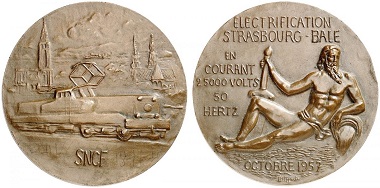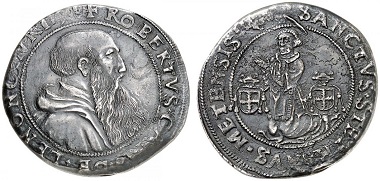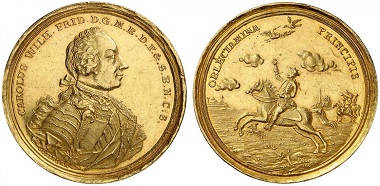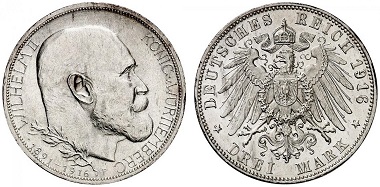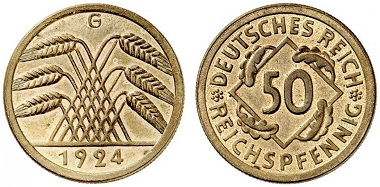15-05-2017 – 16-05-2017
Auction 71 and 72
Magnificent collections of Lorraine and German fractions at Grün in Heidelberg
The Heidelberger Münzhandlung will conduct its two Spring Auctions on May 16-17, 2017, at the Europäischer Hof Heidelberg. As usual with Herbert Grün, the offered material is of the finest quality imaginable. Extremely fine and above virtually constitutes the average grade. The focus is placed on German coins – as usually. In addition to rare coins from the German States and the German Empire, in Auction 72 Grün offers a collection of 1,420 lots with fractions after 1871 in an outstanding grade.
Lot 1793. Besançon, city. Double ducat no date (1642-1664) with the title of Ferdinand III. Only 27 specimens struck every year. Extremely rare. Extremely fine. Estimate: 10,000 euros
In the foreign section, remarkable series can be found as well. The impressive collection of French féodal coins, strikings of the non-royal minting authorities in France, certainly constitutes the highlight. One of the most important Lorraine collections ever to be auctioned off can be discovered here. A large selection of coins and medals of the free Imperial city of Strasbourg round up the picture.
Lot 2184. Strasbourg. Bronze medal 1957 by Belmondo on the electrification of the Strasbourg – Basel railroad. Extremely fine. Estimate: 80 euros
Although this preview mainly mentions the expensive coins, it is important to remember that Grün always makes sure to offer interesting items also in the two-digit regions. Therefore, everybody will benefit from inspecting the material closely.
Lot 1820. Lorraine. René II, 1473-1508. Florin d’or, no date, Nancy. Very rare. Extremely fine. Estimate: 7,500 euros
France of the Feudal Lords
The almost 200 lots with ancient coins will be followed up by the European foreign countries, with a collection of almost 500 lots of “féodales”, as the French technical term reads. This refers to all the dukes, counts, bishops, abbots, and cities with the right to strike coins before the French kings started to progressively restrict their vassal’s coin minting. The spectrum ranges from the Duchy of Bar to Weissenburg in Alsace. Beautifully illustrating the history of this region, over which Germany and France once fought, the more than 200 lots with Lorraine coins and medals are the unchallenged highlight. If you want to learn more about this, please read our article of the week. Here, we present the collection’s most spectacular objects to you featuring their historical background.
Lot 1865. Lorraine. Charles III, 1545-1608. Taler 1603, Nancy. Almost extremely fine. Estimate: 4,000 euros
7,500 euros is the estimate of the extremely rare florin d’or, minted in Nancy, of Duke René II (1473-1508). His name is known mainly because he fought alongside the Confederates against Charles the Bold (Lot 1820, EF, estimate: 7,500 euros). The great artistic skill with which the Lorraine die cutters designed the portraits becomes readily apparent by a look at a 1603 taler of Charles III. The extremely fine striking depicts a ruler whose face has been carved in minute detail (Lot 1865, almost EF, estimate: 4,000 euros).
Lot 1880. Lorraine. Charles IV, 1625-1634. Double pistole 1631. Extremely rare. Very fine. Estimate: 10,000 euros
Not one but two examples of the extremely rare double pistole of the same ruler will be available (Lot 1866f., both VF, estimate each: 10,000 euros). At least as rare is a 1631 double pistole of Charles IV, whose reverse depiction harks back to the well-known portugalöser (Lot 1880, VF, estimate: 10,000 euros).
Lot 2000. Lorraine. Charles Alexander, 1761-1780. Only 48 specimens struck! Extremely fine. Estimate: 10,000 euros
Aside from a multitude of silver and gold coins, the collector had also assembled interesting medals. For instance, a gold token, of which only 48 specimens were struck, bearing the portrait of Charles Alexander, the younger brother of Emperor Francis I, husband of Maria Theresia (Lot 2000, EF, estimate: 10,000 euros). With only 8 specimens produced, an even rarer gold medal also features his portrait. It was made to commemorate the shooting contest held on the occasion of the 1000th anniversary of the death of Saint Rumbold in Mecheln in 1775 (Lot 2003, EF, estimate: 5,000 euros).
Lot 2021. Metz, bishopric. Robert de Lénoncourt, 1551-1555. Écu 1551. Very rare. Extremely fine. Estimate: 6,000 euros
Not from Lorraine but from Metz comes an écu with the impressive portrait of Robert II de Lénoncourt (Lot 2021, EF, estimate: 6,000 euros).
Lot 2037. Orange, principality. William IX, 1647-1650. Half écu 1649. Very rare. Very fine to extremely fine. Estimate: 5,000 euros
Why Wilhelm I von Nassau-Dillenburg became better known as William of Orange is illustrated by a half écu of the French principality of Orange that was bequeathed to the future leader of the Dutch War of Independence (Lot 2037, VF-EF, estimate: 5,000 euros).
Lot 2410. Sweden. Sigismund, 1592-1599. Taler 1594. Extremely rare. Well struck. Extremely fine to mint state. Graded NGC AU58. Estimate: 25,000 euros
England, Russia, Sweden, and China
Much more could be written about France, but of course other interesting items come from other regions of the world, too. For example, a large series of medieval groats and shillings originate from England and a series of 50 lots, mainly consisting of modern coins, from China. The admirers of Swedish coins will get the opportunity to acquire a 1594 taler of Sigismund, in the rarely encountered grade extremely fine to mint state (Lot 2410, estimate: 25,000 euros).
Lot 2349. Nicholas I, 1825-1855. Gold Award Medal no date (1835) of the Moscow Practical Academy of Commercial Sciences. Extremely rare. First strike. Estimate: 10,000 euros
The Heidelberger Münzhandlung will offer almost 150 lots comprising Russian coins and medals in gold, silver and bronze: for instance, the first strike of a gold Award Medal of the Moscow Practical Academy of Commercial Sciences from 1835 (Lot 2349, estimate: 10,000 euros), a very rare 1797 roubel from Saint Petersburg (Lot 2320, VF-EF, estimate: 4,000 euros), and an extremely rare 10 kopeck piece dating from 1796 (Lot 2308, F-VF, estimate: 6,500 euros).
Lot 2715. Brandenburg-Ansbach. Karl Wilhelm Friedrich, 1729-1757. Gold strike of 12 ducats from the 2nd falkentaler. Unedited in this weight in gold. Extremely rare. Extremely fine. Estimate: 25,000 euros
Germany
As is tradition with the Grün company, a focus is placed on Germany. The spectrum ranging from Altenburg to Zellerfeld, the connoisseur discovers objects that are rare, exquisite and have not been encountered for a long time, most of which come in a marvelous grade. As always, there will be a broad selection of fractions, supplemented by a series of bracteates.
It goes without saying that there will be the great rarities present as well. Let us start with an unedited gold strike of 12 ducats from the so-called ‘2nd falkentaler‘ of Karl Wilhelm Friedrich of Brandenburg-Ansbach. It features the margrave pursuing falconry which was considered THE leisure activity of any true ruler since the time of Emperor Frederick II (Lot 2715, EF, estimate: 25,000 euros).
Lot 2807. Frankfurt, city. Double gulden 1848 “BERATHUNG Ü. GRÜNDUNG E. DEUTSCHEN PARLAMENTS”. Mule J. p. 72. Very rare. First strike, almost FDC. Estimate: 17,500 euros
A piece that stands out among the small series of coins from Frankfurt is the first strike, in the finest FDC grade, of the historically so important double gulden of the city of Frankfurt. Minted in 1848 to commemorate the founding of the German Parliament, the piece has an unusual combination of dies (Lot 2807, estimate: 17,500 euros).
Lot 3153. Saxony, Albertine line. Frederick August I, 1694-1733. 5 ducats 1714, gold strike from the 1/2 taler. Unedited! Extremely fine. Estimate: 30,000 euros
Its rarity is even surpassed! The relevant item is an unedited 5 ducat piece of August the Strong dating from 1714 (Lot 3153, EF, estimate: 30,000 euros). Generally speaking, every collector of Saxony should examine the catalog with care. In total, roughly 220 lots will come under the hammer, covering all the main lines and the branch lines.
Lot 3194. Saxe-Coburg-Gotha. Ernst I, 1826-1844. Konventionstaler 1835, Gotha. First strike, almost FDC. Estimate: 13,500 euros
Let us conclude the preview’s part about the German States with the first strike of an 1835 konventionstaler of Ernst I of Saxe-Coburg-Gotha, father of the English prince-consort Albert (Lot 3194, almost FDC, estimate: 13,500 euros)
Lot 4170. Saxe-Coburg-Gotha. Ernst II, 1844-1893. 20 marks 1872. The rarest of all imperial gold coin types, in an extraordinary grade. Almost FDC. Estimate: 75,000 euros
Post-1871 German Coins
The Heidelberger Münzhandlung has virtually built up a reputation for its broad offer of German Imperial coins in outstanding grades. With its 71st catalog, it continues to live up to this reputation. Without further comment on our part, these are some of the great rarities:
In the section of fractions:
- Lot 3443, 10 pfennigs 1896 G, J. 13, FDC, estimate: 1,000 euros
You will find more fractions in the specialized catalog accompanying Auction 72.
Lot 3793. Wuerttemberg. Wilhelm II, 1891-1918. 3 marks 1916 on the 25th reigning jubilee. FDC / proof. Estimate: 7,000 euros
In the section of silver coins:
- Lot 3480, Baden, 5 M 1888, A without bar, J. 27, FDC, estimate: 5,500 euros
- Lot 3565, Hesse, 5 M 1876, J. 67, FDC, estimate: 6,000 euros
- Lot 3569, Hesse, 5 M 1888, J. 69, FDC, estimate: 5,750 euros
- Lot 3793, Wuerttemberg, 3 M 1916, J. 178, FDC / proof, estimate: 7,000 euros
In the section of gold coins:
- Lot 4001, Mecklenburg-Strelitz, 10 M 1873, J. 235, VF, estimate: 16,000 euros
- Lot 4003, Mecklenburg-Strelitz, 20 M 1905, J. 240, almost FDC, estimate: 15,000 euros
- Lot 4170, Saxe-Coburg-Gotha, 20 marks 1872, J. 270, almost FDC, estimate: 75,000 euros
Let us conclude the preview of Catalog 71 with a circulation coin from the Federal Republic of Germany from 1957, bearing the edge lettering “Grüss dich Deutschland aus Herzensgrund” (translating as ‘Welcome, Germany, from the bottom of the heart’)
(Lot 4418, EF-FDC, estimate: 5,000 euros)
Lot 1197. Weimar Republic. 50 reichspfennigs 1924 G. Extremely rare in this grade. First strike. FDC. Estimate: 11,000 euros
Catalog 72: Collection of German Imperial Fractions, Weimar Republic, Third Reich, and Allied Occupation of the Finest Quality
Every collector of German fractions should study this catalog meticulously. It entails such a variety of rare variants and years in superb grades as it can only rarely be found. The estimates for the more than 1400 lots range from 25 euros for a mint state 1875 pfennig from Berlin (Lot 12) to 11,000 euros for a mint state first strike of 50 reichspfennigs, minted in Karlsruhe in 1924 (Lot 1197). Chronologically speaking, it covers a range from the German Empire via the substitute coins of World War I, the Weimar Republic and the Third Reich, to Germany under Allied occupation.
Lot 319. German Empire. 1 mark 1883 F. Of great rarity in this grade. Proof. Estimate: 5,000 euros
As cover piece, the auctioneer did not choose one of the lots with the highest pre-sale estimate but an absolutely perfect 1 mark piece 1883 F (J. 9). Having been produced in proof, it is of the utmost rarity in this grade (Lot 319, estimate: 5,000 euros).
Making a choice from this multitude of rarities is really a hard thing to do. And so, also without any further comment, here you can find another list:
Lot 213. German Empire. 20 pfennigs 1887 E, with star below the value mark. J. 6. Extremely rare. Fast FDC. Estimate: 5,000 euros
- Lot 213. German Empire. 20 pfennigs 1887 E, with star below the value mark. J. 6. Extremely rare. Almost FDC. Estimate: 5,000 euros
- Lot 259. German Empire. 1 mark 1873 C. J. 9. Of great rarity in this grade. FDC. Estimate: 6,500 euros
- Lot 297. German Empire. 1 mark 1879 A. J. 9. Of the utmost rarity in this grade. Almost FDC. Estimate: 10,000 euros
- Lot 309. German Empire. 1 mark 1881 G. J. 9. Of the utmost rarity in this grade. FDC. Estimate: 7,500 euros
Lot 580. German Empire. 5 pfennigs 1896 G. J. 12. One of the best specimens known to exist. Good very fine. Estimate: 6,000 euros
- Lot 580. German Empire. 5 pfennigs 1896 G. J. 12. One of the best specimens known to exist. Good very fine. Estimate: 6,000 euros
- Lot 852. German Empire. 1/2 mark 1908 F. J. 16. Of great rarity in this grade. Proof. Estimate: 7,500 euros
- Lot 888. German Empire. 1 mark 1891 D. J. 17. Of the utmost rarity in this grade. Almost FDC. Estimate: 7,500 euros
Lot 1053. German Empire. 1 pfennig 1916 G. J. 300. Very rare in this grade. First strike. FDC. Estimate: 1,000 euros
- Lot 1053. German Empire. 1 pfennig 1916 G. J. 300. Very rare in this grade. First strike, FDC. Estimate: 1,000 euros
- Lot 1197. Weimar Republic. 50 reichspfennigs 1924 G. J. 318. Extremely rare in this grade. First strike. FDC. Estimate: 11,000 euros
Lot 1242. Weimar Republic. 50 reichspfennigs 1932 G. J. 324. Extremely rare in this grade. First strike. FDC. Estimate: 2,000 euros
- Lot 1242. Weimar Republic. 50 reichspfennigs 1932 G. J. 324. Extremely rare in this grade. First strike. FDC. Estimate: 2,000 euros






